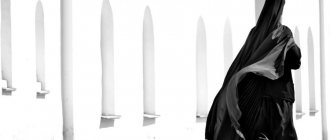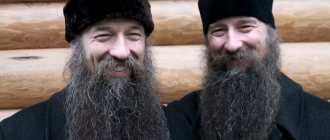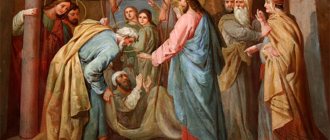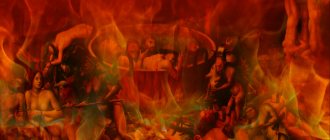Why are priests fat?
This is not the first time we have been asked why many priests are overweight. Indeed, after ordination, many clergy begin to recover. This question is so relevant, probably because the obesity of priests gives the impression that they do little physical work, eat and sleep a lot. And this is not at all true. How can this phenomenon be explained?
Hieromonk Oleg (Osipov), a resident of the Ascension Pechersky Monastery in Nizhny Novgorod and a doctor, answers: I myself have often heard this question. The answer to this, I believe, cannot be unambiguous. I can only list those reasons that lie on the surface. First of all, we need to understand how the life of a person who decides to change his worldly life and devote himself to serving God changes. Breaking away from ordinary worldly life, a person, among other things, takes upon himself the obligation to live according to the church charter. This charter includes a special daily routine and a special diet. The routine of a clergyman’s life excludes almost all types of active recreation and entertainment. In particular, sports games, dancing and the like. The service itself consists, as everyone knows, of performing church services, demands and prayers, which are performed in a low-moving state. If we consider physical labor within the framework of a subsistence economy, it should be noted that the percentage of rural priests who can devote themselves to rural labor without compromising their main service is not so high due to the fact that in a rural parish, most often, only one priest serves . And all the parish problems fall on his shoulders. And these problems today, as a rule, are of an administrative nature. We can’t help but mention the posts. Despite all the benefits of fasting for our humility and spiritual development, it should be noted that all products for a Lenten meal, for the most part, are easily digestible carbohydrates and high-calorie vegetable fats. And the priest’s diet is unique. In particular, the priest does not have the right to eat food until the end of the liturgy, even if he is not serving. Thus, breakfast is excluded. And during the day there is almost always a lot to do - demands, etc. — and there’s not enough time for lunch. It turns out that only dinner remains. So all the priests gorge themselves at night, which is very harmful. The lives of priests are no less stressful than those of ambulance workers or firefighters. The same confession is not just listening to someone's sins with absolute indifference. Each confession is a personal experience of the problems and hardships of your neighbor. The priest becomes a witness to the revelation of sins and realizes the full extent of his responsibility for the repentant before the face of God. The sacrament of the Eucharist is the same - it requires from the priest the maximum concentration of all his forces. It’s the same in parish life: the priest is responsible for the entire parish, the temple and church utensils. So there is enough stress. How do we fight them? Most often, we just eat. What do we have as a result? Metabolic disorders plus gastrointestinal diseases. On the other hand, the innate constitution of a person, his predisposition to being overweight or thin, may also have an effect here. It is difficult for me to judge the complexion of the holy fathers who lived in the first centuries of Christianity. The Lives preserved neither descriptions of the appearance nor information about the weight of the saints. And the iconographic tradition prescribes depicting saints as thin.
The thickness of the clergy sometimes became the cause of the most unexpected phenomena. For example, ethnographers describe the custom in some provinces, as part of agricultural rituals, to roll a priest across the field, saying, “Be born a sheaf, thick as a priest.” Of course, this is a vivid example of the so-called. dual faith, essentially pagan rituals in a semi-Christian shell, however, it can be noted that the thickness of the “butt” was not thought of as a negative quality, but as a guarantee of a rich harvest
Recorded by Anna Palcheva
Myths about church ministers
If you believe popular rumor, the clergy, despite their apparent infallibility, has a number of negative qualities:
- Lack of physical labor. The specificity of the work of clergy is such that they rarely have to shoulder the heavy burden of working with their hands;
- According to Hieromonk Oleg Osipov, the laity attribute excessive sleep time to the clergy. Allegedly, they spend most of the day in the arms of Morpheus, freed from the need to earn their daily bread;
- Gluttony. Priests at all times in Rus' were quite well-fed people. In ancient times, there was a custom to roll the owner of a large belly across the field to wish for a large harvest.
The last myth is the most common, so it is worth debunking it first.
Occupational diseases of clergy
Almost any job has some negative impact on health. The service of the Church is no exception. Many years after ordination, the following illnesses make themselves known:
- Diabetes. Fasts that are important for the humility of a believer can lead to such an incurable illness;
- Thyroid gland dysfunction. The reason for this is hormonal imbalances and age-related decline in metabolism;
- Cardiovascular diseases;
- Phlebeurysm. The specificity of a number of church rituals is such that it is necessary to stand on your feet for hours;
- Both women and men in office suffer from ailments of the reproductive organs;
- Impact of stress. Clergy communicate not only with the Lord through prayers, but also with ordinary sinners. The consequences of such communication can have a very negative role;
- Diseases of the gastrointestinal tract. Eating irregularly during the day leads to the corrosion of the stomach walls by acid. Which in turn causes gastritis or ulcers.
Popular Russian humorist Mikhail Zadornov once wondered why priests have big bellies when they have to observe strict fasts. According to the Soviet comedian, giving up fatty foods several times a year should lead to a model figure. In reality, the situation is exactly the opposite: religious prohibitions regarding food only lead to excess weight gain.
This popular demotivator on the Internet has been circulating on the Internet for a very long time. But this is actually a fake and I will write about it in more detail tomorrow in the “Exposing!” section. But this fake did not appear out of nowhere. The question of the “volume” of clergy among others is probably often asked by believers and especially atheists. The obvious answer lies on the surface. All clergy are sinners and greedy for money and worldly goods. They eat whatever they can get their hands on and in large quantities, that’s why they are so voluminous. But is it all that simple? After all, being a priest means observing fasts and participating in services and other ceremonies. Can lifestyle and poor nutrition cause overweight and obesity? Let's discuss this issue and try to sort it out in a difficult situation.
In Orthodoxy, fasts, on the one hand, are stricter and more frequent (more than half of the days a year are fast!), and on the other hand, they are less “regular.” Among Catholics there are very severe ascetics, but then they are real ascetics - they not only do not eat meat, but do not eat at all. A crust of bread there or a bowl of soup for the day. Or even that. The majority of Orthodox Christians (we don’t accept ascetic monks) have long moved away from the practice of fasting as abstaining from food altogether. As a result, we get: if we often refuse animal food, we save ourselves from hunger with something filling and carbohydrate-rich: bread, potatoes, cereals... But we still want to eat, so we sit down to tea and cookies three times a day. If the priest is active, then he does not sit down for tea three times a day. He generally eats incorrectly and irregularly. During the day he grabs some pieces, hastily crossing them, and late in the evening, well after six, when he comes home, he eats them. A hungry and tired person can eat a lot. Which is what it does. (Catholics can also be hungry, tired and active, it’s just that in our country this is a more common phenomenon - specifically, the Russian Orthodox Church is still in a state of restoration, so you have to run and work a lot. The priest’s wife is often a woman with many children with another baby under her arm, cooks what is simpler - that is, again, potatoes, pasta, and that's all. Catholic priests quite often have something like housekeepers - they, single celibate men, help them with the housework, including with food A priest in the outback is also quite often not rich (well, that is, he is rarely completely poor, but he has much more pressing problems than finding lean beef or dietary trout) - after all, his parishioners feed him, donating to the temple, and the parishioners too , frankly, not millionaires - our standard of living is significantly lower than in Catholic Europe. That is, again, potatoes, pasta, bread, sausages. In Orthodox countries, where the standard of living, the quality of food and the state of the Church are somewhat better, priests look healthier. Among the Greek or Serbian priests you will not meet many obese people. Answer from priest Sergius Ryabko: As you know, there are occupational diseases. For clergy this is due to a special way of life and the observance of numerous fasts. As a rule, these are cardiovascular diseases, diabetes, varicose veins, stomach diseases, etc. Monastics of both sexes suffer from diseases of the reproductive system. Among the clergy it is not customary to have breakfast, but to have lunch straight away, eating food at noon. The priest celebrating the Divine Liturgy has no right to eat or even drink, from midnight until the end of the Liturgy, which happens around noon, which is why another name for the Liturgy is Mass. Fasts, as a rule, are observed strictly, and these are 7 weeks of Great Lent in the spring, from 3 to 5 weeks of Peter's Fast in the summer, 2 weeks of the Assumption Fast, 40 days of the Nativity Fast. Fast days are also Wednesday and Friday throughout the year. During fasting one does not eat the so-called meager food, i.e. animal origin: meat, milk, eggs, as well as products that contain the above ingredients. Sometimes on fasting days it is permissible to eat fish. Since the body demands its own, the lack of high-calorie food is compensated by a large amount of bread, pastries, pasta, potatoes, vegetable fats, which most often causes a tendency to be overweight. Priests spend most of their lives either standing on their feet before the Throne or sitting. Few people engage in physical labor. A sedentary lifestyle with age also contributes to obesity. Going to fitness clubs and working out on exercise machines is not so much a sin, it’s more like there’s no time, because... The day and work week of a clergyman are not standardized. Before the revolution, the rural clergy had a plot of land and received most of their income from it, i.e. The priest and his family members cultivated the field with their own hands in their free time from services. Therefore, before the revolution, the rural clergy were distinguished by their slimness and health. It constituted up to 90% of the total number of clergy. Now the village is destroyed, most of the parishes are located in cities. Very often, even if the parish is located in a village, the priest lives in the city. There is not enough clergy, so there is a practice of one priest ministering to several parishes, i.e. he takes turns touring his parishes, sometimes by public transport.
The concept of fasting also includes abstinence from married life. But in this area the rules of the Orthodox Church are even more strict. Marital relations are prohibited not only by fasting on the night before the fast days of Wednesday and Friday, but also on the night before holidays and Sundays. And also the day before, on the day of Communion of the Holy Mysteries of Christ and the night following that, i.e. when a clergyman or deacon celebrates the Divine Liturgy, and this happens several days a week. It is clear that abstinence from married life leaves unused calories, which also tend to contribute to obesity. As for me, I’m a sinner: I’ve loved to eat since childhood. This is the only reason why I am fat. Regarding Catholics, I doubt the statistics. Where and how many Catholic priests did you see, where and how many Orthodox priests? I saw a lot of fat Orthodox priests on TV, but in my life (in the churches I visit) I have never seen a single fat one.
And here is the answer to a question from other priests: All priests are fat because they eat a lot and deliciously - this is a myth. Firstly, not all Orthodox priests are fat. Neither we nor our opponents have conducted studies that could establish whether there really are more overweight people among priests than among non-priests. Secondly, the average priest is older than the average man, because priests are not often made at a young age. Probably less than half of the priests became priests through the most direct route: school - seminary - priesthood. Many people came to this at a more mature age. And the older a man is, the larger his belly, unfortunately.
Third, mature non-priests often wear jackets. The jacket hides the stomach. But the clothes of priests do not hide. Therefore, the belly of a person wearing priestly clothing (cassock) is more noticeable. And finally, the most important thing. Let's finally speak as adults who have experience in their own struggle with subcutaneous fat. What actually determines the thickness of the fat layer? From wealth? From the sophistication of the food? Nothing like this. Most of all it depends on diet and sports training. Having a normal working day, you can avoid evening overeating and devote time to training in the gym.
Priests have irregular working hours. On days of worship, they have the opportunity to eat for the first time only at three o'clock in the afternoon. In addition, almost all of them are fathers of many children. According to many priests, they often don’t even have time to comb their hair. Why go to the gym for beauty, while a mother with 3-5-8 children is tearing herself apart. And not only does the mother need help, but the children themselves need their father’s attention. How many other spiritual children do priests have who also need to devote time? And why do Orthodox priests need this fitness? Body beauty is not one of the priority values for priests. Firstly, they are not concerned with the task of seducing the opposite sex. They all have wives. And to be honest, it is the desire to please and seduce that is one of the main incentives for us to maintain physical shape. Secondly, they generally attach more importance to the spiritual, understanding the short duration of this life, and not seeing the point of investing effort in something that will very soon turn to dust. While there is always not enough time to work on your soul.
Therefore, with their big bellies, some priests look like spiritually weak people who are simply too lazy to take care of themselves. But the priests are strong and not lazy. They just apply their power in a different direction. And what we need from people who should be exponents of God’s paternal love for us is not at all the beauty of the waist. Think and tell me honestly - would you prefer to deal with a priest who devotes more time to you or who spends less time but has a thinner waist because he goes to the gym? And one moment. Everyone knows that kind people are more prone to being overweight than evil people. There is even a saying: “There must be many good people.” Indeed, anger and other evil emotions seem to burn a person’s flesh. Priests are different people, but nevertheless their service, willy-nilly, pacifies their soul, teaches kindness...
Vitaly Milonov’s answer: “Do you know why our priests are fat?.. No? But I know, because I am a man of the church. It's all because of the services. Before twelve or two o'clock in the afternoon, Orthodox priests do not eat. Catholics are lean because they live in hot climates. By the way, Orthodox priests in Cyprus are generally thin,” Milonov said. Constant fasting, during which you cannot eat anything except bread and potatoes, also harms your figure. “I can say that more than fifty percent of priests have diabetes, precisely because we have poor nutrition,” the deputy noted. The Greeks are luckier here too - during Lent they can eat a lot of greens and fruits, which are unavailable in our northern conditions. Or maybe simply because most lean foods contain carbohydrates. And excess carbohydrates, as you know, are converted into fat reserves. Try eating one piece of bread with potatoes or beans with nuts. Or is there more than one bread and potatoes there?
The effect of fasting on the body
Abstinence in food is an integral part of the life of religiously minded people. However, any violation of the normal diet can play a disservice to the body:
- Orthodox Christians must carefully observe several multi-day fasts every year. In addition, the third and fifth days of each week are also fast;
- After many years, the body gets used to a carbohydrate diet (fruits, vegetables, pasta, etc.);
- Since carbohydrates are a source of energy, it should be spent wisely. Not every priest goes in for sports, which affects his figure;
- The lack of fats makes itself felt at the end of fasting, when the body, hungry for them, begins to intensively store them;
- The specific diet also matters. Breakfast for a clergyman is practically excluded, since eating food is prohibited until the end of the morning service. A large number of worries during the day also does not encourage a hearty lunch. Thus, a tradition has developed of overeating at night, which is very harmful.
Age and individual characteristics
Other factors may also be to blame for the formation of a large belly:
- Features of the male body. If a woman, when gaining weight, gains excessively voluminous hips, then a man risks becoming the owner of a majestic mammon;
- A significant portion of clerics are constitutionally mesomorphic, i.e., they are prone to gaining a fuller figure with age. This is an innate trait that cannot be changed even with constant exercise;
- After 40 years, there is a significant risk of getting hyperlordosis - this is a disease of the spine in which there is a significant forward deflection of the lower back. Those suffering from this disease are visually perceived as fat people, although they may not be overweight;
- The specific attire of Orthodox clergy only emphasizes the flaws of the figure, and does not hide them;
- Sexual abstinence also makes its contribution during fasting and holidays;
- As we age, metabolic processes in the body are disrupted. Every ten years, a mature person’s metabolism drops by 7-8%.










